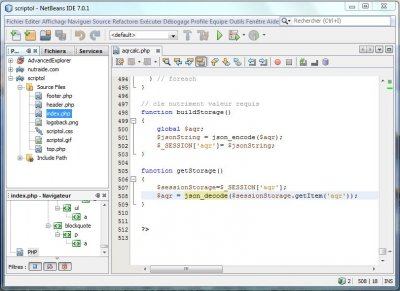EDI (or IDE), functions, and list
Integrated Development Environment (IDE) with graphical user interface. It is a tool that makes it easier for a programmer to implement applications or write scripts.
EDI includes at least:
- Graphical interface.
It includes selecting files, defining parameters, starting operations. - Source editor with syntactic coloring.
- Configuring compiler.
- Link Editor.
- Constructor (built-in tool). It passes commands to the compiler and the link editor with the source files or object modules in the settings.
- Debug tool.
Alternatively, you can also:
- Multi-language support.
- Syntax error detector.
- Autocomplete code.
- Plugins.
- A tool for visually building interfaces with copying and pasting widgets.
- Navigating classrooms.
EDIs can be devoted to a programming language or be multilingual. In the second case, the editor adapts the syntactic coloring to the language, depending on the file extension or user choice.
EDI Netbeans is akin to a simple code editor with a list of source files on the left and an edit box on the right, but it is actually much more elaborate. It has a built-in syntax tester for supported languages, which detects errors, allows you to hide the body of the function for easier display, can interact with the database to execute the code under test.
And, of course, has classic development tools...
To further automate the production of applications, other tools may be included in the EDI:
- Class tree panel and its members. It provides easy access to program elements.
- Visual designer. By selecting graphic components in columns, you can create an interface by dragging and dropping.
- Context-sensitive Help. Provides a function and method for using each element.
- Version Manager. Supports serial source versions.
- Profiler. Helps optimize code and improve performance.
Modern text editors such as Bracket, Visual Studio Code, in addition to syntactic coloring, have advanced functions such as autocomplete, syntax correction. This is also necessary in EDI.
List of free EDIss
These are all multilingual tools. For specialized tools, see each language on the home page of this programming folder.
- Visual Studio Community
C++, C #, Basic, HTML 5. Became free in 2014.
For Windows. - Eclipse.
Software in Java, a multilingual development platform that includes the same tools. You can add your own tools.
This software is difficult to understand and not appreciated. In particular, there are complaints about unstable plugins, slowness and difficulties in accessing components. Its advantages are good SVN and CVS management, a wide range of supported languages . - KDevelop.
EDI, intended mainly for C applications, but supporting other languages, including OpenCL.
For Linux and Windows . - IntelliJ IDEA.
The Community edition is free. Differs in a gray background by default, runs Java and HTML 5 applications for the desktop or for Android in the CE version, and other languages for the pro version. Good debugger, refactoring support .
For Windows/Mac/Linux. - Aptana Studio.
To create web applications with HTML 5, PHP, Ruby. Internet automation and Git support.
For Windows. - Light table.
A developed editor (based on CodeMirror and Node), which includes an HTML rendering engine (NWJS ex-Node-Webkit) and a kind of internal server. It is intended for dynamic languages such as ClojureScript, JavaScript, Python and can be supplemented with plugins for other languages. It allows you to evaluate code and connect to a virtual user to validate the code and change it at run time. Browser integration allows you to see the result of changes without reloading the page, which is ideal for the Node.js project.
For Windows/Linux/Mac. - No, Bean.
Java, PHP, C++ applications. It has syntactic correction, access to the source files is displayed only when necessary and frees the screen otherwise. Integrated Maven for project management. It is well suited for web applications.
Support for Git, CVS, SVN .
For Windows/Mac/Linux.
